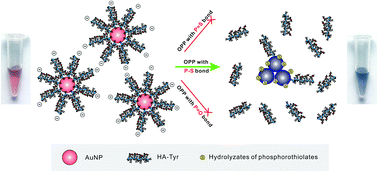Hyaluronan–tyrosine–gold nanoparticles as an enzyme-free colorimetric probe for the detection of phosphorothiolate pesticides†
Abstract
Detection of organophosphorus pesticides (OPPs) is crucial for food safety and environmental protection. Here, we propose an enzyme-free strategy for the detection of phosphorothiolate pesticides, a major class of OPPs with P–S bonds, by using hyaluronan–tyrosine–gold nanoparticles (HA–Tyr–AuNPs) as the colorimetric probe. The strategy is based on the concept that the surface of AuNPs can be directly modified by the hydrolyzate of the phosphorothiolate in a strongly basic HA–Tyr–AuNP colloidal solution, which in turn affects the aggregation state of AuNPs and hence produces a red-to-blue color change. This method is very simple in design and easy to operate. The detection requires only the addition of the analyte into the HA–Tyr–AuNP colloidal solution at room temperature. By virtue of the absorbance variations of the analytical system, the limit of detection for phorate is as low as 0.005 μg mL−1 (i.e., 0.006 mg kg−1), which is lower than the maximum residue limit (MRL) allowed by the European Union. More importantly, phorate residues in real samples can be directly detected by this method.



 Please wait while we load your content...
Please wait while we load your content...